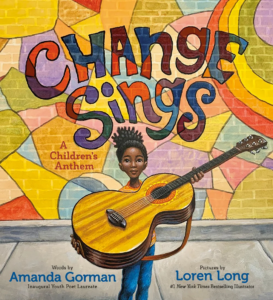Change Sings 4-5 (Music)

Art Form: Music
Supplies Needed
Change Sings book
Vocabulary
Ostinato - short repeated pattern
Body percussion - creating sounds using your body (ex. patting your legs, clapping, stomping, mouth sounds, etc.)
Rhythm - pattern of short and long sounds in a musical
composition
Steady beat - a rhythmic pattern that holds a regular pulse
Theme - the message the author communicates through the text
Text structure - how the text is built, or organized
Anthem - an uplifting song identified with a group, body, or cause
Instructions
1. Read the book's full title, including “A Children’s Anthem.” Discuss what an anthem is with your child.
2. Discuss the purpose for reading the book - to find the theme. What message is the author trying to convey?
3. Read through the book once. Discuss the theme. Write a short, meaningful phrase that conveys the theme and can be used for your ostinato, such as “We are the change” (over 4 beats) or “We all want change. Won’t you sing along?” (over 8 beats).
4. Decide on a rhythm for your ostinato. Decide how often you want to perform the ostinato while rereading the text. Will you perform it after every page? Reread the text while performing your ostinato.
5. Make changes, if necessary, to your ostinato pattern. Choose body percussion to add to your performance.
6. Reread the text once more, performing your revised ostinato and body percussion.
Extensions
Record your performance and share it with other family or school members.

About
The REimagining and Accelerating Literacy through Arts Integration (REALAI) grant supports the literacy achievement of 3,200 students and 170 teachers, media specialists, and literacy coaches across six schools in Georgia and South Carolina.
In addition to professional learning for educators, this project contributes significantly to school library collections through the purchase of developmentally appropriate and culturally relevant books.
This grant also includes parent events to provide families with access to books and other content about how to support their child’s reading development.


